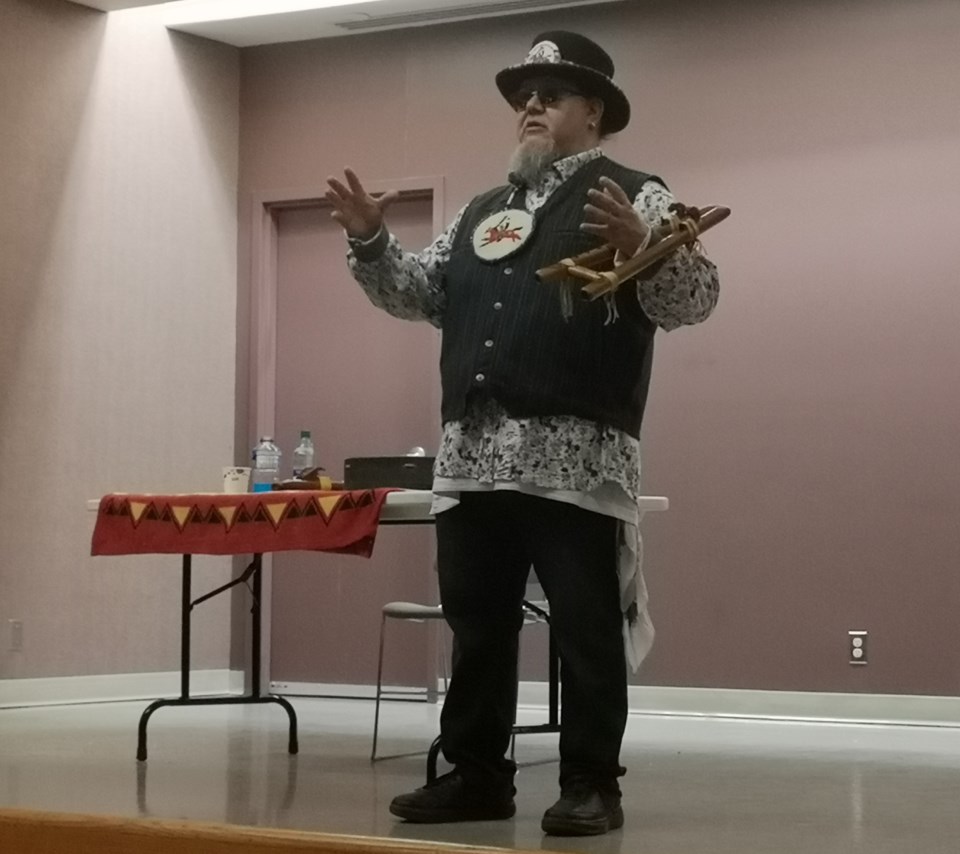On the morning of Feb. 22, Indigenous master storyteller Dickie Yuzicapi contributed to the ongoing celebration of Aboriginal Storytelling Month at the Moose Jaw Public Library’s theatre.
Continuing his own tradition of storytelling since the age of eight, Yuzicapi used an expert blend of humour, emotion, experience, and song to communicate moral lessons and share insights into the Indigenous way of life.
The presentation was supported by the Library Services for Saskatchewan Aboriginal Peoples (LSSAP) organization, who co-ordinates the Saskatchewan Indigenous Storytelling Month each February.
The practice of Indigenous storytelling is steeped in an age-old tradition spanning countless generations. These stories are communicated through voice, song, drumming, in pictographs, and through structures such as medicine wheels.
Stories are usually told in a designated environment, such as a healing circle, and allows individuals to share their story – which can oftentimes be an account of their traumatic experiences.
Indigenous storytelling helps individuals heal by allowing them to come to terms with the emotional pain caused by what had transpired in their past. Story can help individuals make sense of how their personal journey fits in relative to the communal story shared by others.
Yuzicapi’s story follows this tradition closely and blends light-hearted humour, accounts of creation, as well as his own emotionally touching story that included the death of his grandfather and the loneliness he felt while attending a residential school as a child.
Indigenous storytelling, according to Yuzicapi, is about taking the listener on a shared journey.
“Using hand gestures, I’m taking you on a journey and letting you see what I want you to see and to hear what I want you to hear. That’s what storytelling is,” he explained. The storyteller must also believe the story they’re telling, which is why many stories are recollections of a personal experience.
“I’m not sitting here in a big chair opening a book and reading you a story.” The reason why, he said, is due to oral tradition. “The book does not exist – the book was taught to me orally… and I’m (passing it) down to you.”
It begins with the story of creation from an Indigenous perspective. This helps explain why we are here and what our purpose might be.
“A long time ago in teepee time…,” he began, the creation story was widely shared.
“When (the Creator) created the big nations, they all gathered together…,” he said. These nations were divided into the Red (Indigenous) nation, Yellow (Asian), White, and Black nations represented on the medicine wheel.
“They started fighting among themselves, and the Creator got mad. He drove his hands into the dirt around that nation, and this nation…,” he explained. This is represented by the great oceans that divide the continents.
“It doesn’t matter the skin colour on the tops of your hands – when you turn your hands over, this part of everybody on earth is the same colour – the same with the bottom of your feet. If you cut yourself, you all bleed the same colour,” he said.
His conclusion was that we all came from one single group of people and share the same story.
Telling stories through song is another long-standing tradition. Yuzicapi said the earliest songs were love songs, and this is in no small part due to the need to express a strong personal and emotional story.
When a young man fell in love with a woman long ago, he was not permitted to touch her or even talk to her. He had to speak to his mother, who then arranged a dialogue with her mother. To prove himself to her, the young man would demonstrate his feelings through a personalized flute melody witnessed by both families.
“This is what we used to catch the ear, to catch the heart, and catch everything else (in) the other sex.”
During his presentation, Yuzicapi demonstrated the key differences between northern and southern Indigenous songs, which he said are divided along the Nebraska line from coast to coast. In the north, songs are typically sung in a higher pitch, whereas songs in the south are deeper and louder.
The louder songs in the south, he said, were due to the need to communicate between tribes which would be located a few miles apart. The removed the need for riders or messengers and allowed great numbers of people to stay connected.
Sadly, many songs from before the 1970s were lost, following the decline of original language usage.
To compensate, many Indigenous songs from the 70s and on are “social songs,” where individuals continue to tell their story in defiance of an otherwise completely lost cultural tradition.
“We lost a lot of stuff as First Nation’s people. We lost our culture, we lost our language, (and) we lost our land – but we didn’t lose our sense of humour.”
Yuzicapi was raised by his great grandparents on the Okanese First Nation. For more than a decade, he learned about his Indigenous culture directly from them.
More recently, Yuzicapi was one of the first storytellers with the LSSAP to share his stories in Regina and continues to share his accounts ever since.
To learn more about Aboriginal Storytelling Month, visit LSSAP.ca/storytelling.




